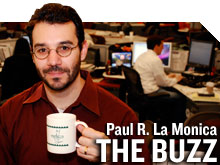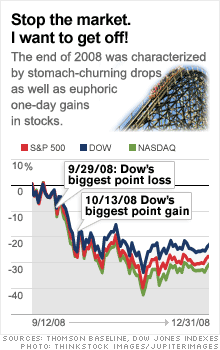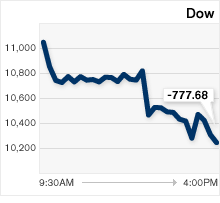The end of the manic depressive market
The Dow suffered its biggest point drop ever a year ago -- but also its biggest point gain. Now, stocks are rallying in an orderly fashion. Thank heavens for that.


 |
| The historic drop on 9/29/08 wiped out nearly $1.2 trillion in market value. |
NEW YORK (CNNMoney.com) -- Wall Street will celebrate a not-so-happy anniversary on Tuesday.
A year ago on Sept. 29, the Dow Jones industrial average suffered its worst point drop in history, plummeting nearly 778 points, after the House of Representatives rejected the first draft of the $700 billion financial rescue plan. The S&P 500 and Nasdaq each plunged about 9% that day.
Of course, the controversial Troubled Asset Relief Program, or TARP, ultimately wound up passing the House a few days later after the Senate approved a modified bill. Some politicians who initially voted against the bailout even attributed fears of another big sell-off as a reason for changing their minds.
The market chaos didn't end with the passage of TARP though. Over the next few months, the Dow suffered its second-largest, fourth-largest and fifth-largest point drops ever -- but also its biggest, second-biggest and third-biggest point gains in history.
Looking back, it truly is amazing how jittery and uncertain investors were about where the economy was heading. Between the time that Lehman Brothers collapsed on Sept. 15 and the end of 2008, the S&P 500 moved up or down at least 3% in one day a stunning 29 times.
Fortunately, the days of insane market volatility appear to be over. Even Monday's triple-digit point rally in the Dow was relatively tame. The Dow gained only 1.3% while the S&P 500 was up 1.8%.
The S&P 500 has experienced a 3% swing only 20 times so far this year. And that could be a sign that the recent rally, despite some concerns about running too far too fast, could be for real.
"The lack of volatility is a sign of good behavior. This is what you should see at the start of a bull market. We've moved from a period of crisis to a period of early recovery," said Todd Campbell, president of E.B. Capital Markets, a Durham, N.H.-based research firm catering to institutional money managers.
In fact, when you look even more closely at the times the market had a big up or down day, almost all of them took place during the first quarter -- a time when investors were fearing the worst for the economy.
None of the 3% gains or losses in the S&P 500 have occurred during the third quarter, and only four of them took place in the second quarter. That means the rally has been an orderly move higher, largely absent of the bipolar market shifts that characterized the fourth quarter of 2008.
Alan Skrainka, chief market strategist with Edward Jones in St. Louis, said it makes sense that stocks are no longer being whipsawed like passengers on a Tilt-A-Whirl.
Skrainka said TARP and other bailout programs, despite their many critics, has helped restore confidence in the banking sector, stock market and economy at large.
"We don't have the extreme volatility anymore because we've reached greater stability in the financial markets. Credit markets have mostly returned to normal," he said. "Many of the problems that were keys to the panic have been addressed and it looks like the economy is coming out of recession."
This doesn't mean that investors can cavalierly dismiss some of the economic concerns that still exist.
Commercial real estate may be a lingering headache for banks. The national unemployment rate is inching closer to 10% and is not expected to fall anytime soon.
And even though large companies are expected to post decent profits for the third quarter, much of that will be due to cost-cutting and the weak dollar as opposed to real revenue growth.
Bill Stone, chief investment strategist with PNC Wealth Management in Philadelphia, said one worry is that investors are starting to expect a robust and rapid rebound in both corporate profits and the economy. That may not come to pass.
In fact, weaker-than-anticipated reports regarding housing sales and durable goods orders helped push stocks lower last week. That just goes to show that the recovery may take longer to unfold and may not necessarily be a smooth one.
"We're in a recovery. But there was mixed economic data last week and the market didn't like it. So investors could get the shakes," Stone said. "When you set the bar higher, there's a better chance you knock the bar off and fall down. The risks have increased."
Skrainka conceded as much. He said that sooner or later, stocks will have to cool off. After all, the S&P 500 is now up nearly 60% since its March low.
"It's been a remarkable rally -- any way you measure it," he said. "So there will be some kind of correction and investors need to factor that in to their planning."
All that said, Skrainka thinks that a correction -- technically defined as a 10% drip from a recent high -- could be just a temporary pause in what may be a new bull market.
Stone agrees. If stocks do pull back, he doesn't think it will be for long. And he is hopeful that such a decline will be as gradual as the recent run-up has been rather than a sudden, sharp sell-off.
"Short term, you have to make the case that stocks are overbought. But the market is now viewed much more stably," he said. "So much of the concerns last year were that we were sinking into the abyss and that the financial system had cracked. We've come a long way since then."
Talkback: Is it a good sign that the markets are no longer as volatile as they were a year ago? Share your comments below. ![]()


